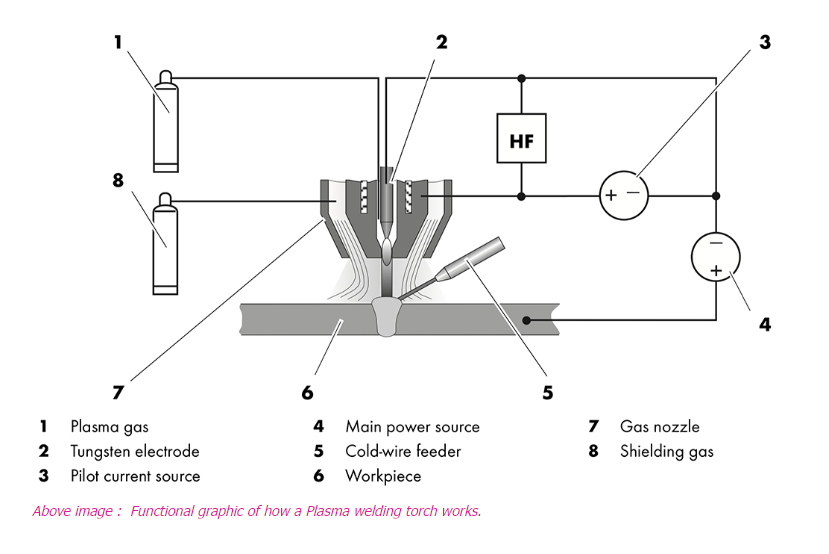What is plasma
One of the most convoluted words in science is the definition of plasma

What is plasma?
Plasma is a basic word referencing blood in medical science. Plasma in geophysics and astrophysics refers to substance as hot as the Sun. The word origination of the word: plasma, is from its Greek definition which means: moldable substance.
Physics now defines plasma as the addition to the three states of matter: gas, liquid, solid, and plasma. This causes obscurity to the name of a Plasma Cutter in the welding industry; since it is heat that produces malleability. In geophysics, the term Plasma as the core of Earth also provides an ambiguous notion; with malleability referring to heat as the source which makes it a liquid state.
With the phenomenally ambiguous meaning of plasma as a moldable substance, this leads one to conclude that plasma is every object, because all objects are formed with molecules. Every molecular structure is moldable. With blood, are the membrane particles of cells holding other particles as a whole be the moldable substance? How is this related to intense heat?
Medical industry
In its biological term, plasma in blood is the yellow hue membrane that contains proteins.
From the A Level Biology website:
Structure of Plasma Membrane
- The plasma membrane (also known as the cell membrane or cytoplasmic membrane) is a biological membrane that separates the interior of a cell from its outside environment.
- It is a fluid mosaic of lipids, proteins and carbohydrate.
- The plasma membrane is impermeable to ions and most water-soluble molecules.
- They cross the membrane only through transmembrane channels, carriers, and pumps.
- These transmembrane proteins provide the cell with nutrients, control internal ion concentrations, and establish a transmembrane electrical potential.
- A single amino acid change in one plasma membrane pump and Cl− channel causes the human disease cystic fibrosis.
- The cell membrane is primarily composed of a mix of proteins and lipids.
- Depending on the membrane’s location and role in the body, lipids can make up anywhere from 20 to 80 percent of the membrane, with the remainder being proteins.
- While lipids help to give membranes their flexibility, proteins monitor and maintain the cell’s chemical climate and assist in the transfer of molecules across the membrane.
- The fundamental structure of the membrane is the phospholipid bilayer, which forms a stable barrier between two aqueous compartments.
- The plasma membrane is composed of a phospholipid bilayer, which is two layers of phospholipids back-to-back.
- Phospholipids are lipids with a phosphate group attached to them.
- The phospholipids have one head and two tails.
- The head is polar and hydrophilic, or water-loving.
- The tails are nonpolar and hydrophobic, or water-fearing.
Plasma in physics
The biological definition does not fit into the physics terminology as being “the fourth state of matter”.
A plasma welder refers to its definition as the use of super-heated gas. From the Abicor Binzel website:
Plasma is a hot ionized gas consisting of approximately equal numbers of positively charged ions and negatively charged electrons. The characteristics of plasmas are significantly different from those of ordinary neutral gases so that plasmas are considered a distinct "fourth state of matter."
Simply put, Plasma is a Gas that has been super-heated to a point where it becomes highly conductive. In Welding and Cutting processes, this allows an electrical current to be transferred.

From the Wikipedia definition, plasma relates to charged particles:
The presence of charged particles makes plasma electrically conductive, with the dynamics of individual particles and macroscopic plasma motion governed by collective electromagnetic fields and very sensitive to externally applied fields. The response of plasma to electromagnetic fields is used in many modern devices and technologies, such as plasma televisions or plasma etching.
Depending on temperature and density, a certain number of neutral particles may also be present, in which case plasma is called partially ionized. Neon signs and lightning are examples of partially ionized plasmas. Unlike the phase transitions between the other three states of matter, the transition to plasma is not well defined and is a matter of interpretation and context. Whether a given degree of ionization suffices to call a substance "plasma" depends on the specific phenomenon being considered.
Plasma as a physics term is defined in the Wikipedia explanation Plasma was first identified in laboratory by Sir William Crookes. Crookes presented a lecture on what he called "radiant matter" to the British Association for the Advancement of Science, in Sheffield, on Friday, 22 August 1879. Systematic studies of plasma began with the research of Irving Langmuir and his colleagues in the 1920s. Langmuir also introduced the term "plasma" as a description of ionized gas in 1928:
The fourth state of matter
Plasma is called the fourth state of matter after solid, liquid, and gas. It is a state of matter in which an ionized substance becomes highly electrically conductive to the point that long-range electric and magnetic fields dominate its behaviour.
Plasma is typically an electrically quasineutral medium of unbound positive and negative particles (i.e., the overall charge of a plasma is roughly zero). Although these particles are unbound, they are not "free" in the sense of not experiencing forces. Moving charged particles generate electric currents, and any movement of a charged plasma particle affects and is affected by the fields created by the other charges. In turn, this governs collective behaviour with many degrees of variation.[21][22]
Plasma is distinct from the other states of matter. In particular, describing a low-density plasma as merely an "ionized gas" is wrong and misleading, even though it is similar to the gas phase in that both assume no definite shape or volume. The following table summarizes some principal differences:
Lightning as an example of plasma present at Earth's surface: Typically, lightning discharges 30 kiloamperes at up to 100 megavolts, and emits radio waves, light, X- and even gamma rays. Plasma temperatures can approach 30000 K and electron densities may exceed 1024 m−3.
Plasma in geophysics

This is a photo of the plasma trail from Atlantis during its re-entry into Earth's atmosphere. The photo was taken from the International Space Station.
If plasma is referred to as a comet trail created by atmospheric interference, what is its relationship to blood? Since the plasma element of blood is referred to as a membrane, does this not apply to other aspects of plasma as a membrane as well? How then is it that the above photo refers to plasma in terms of physics as charged particles?
In the scientific discipline of geophysics, plasma has a different interpretation.
From https://www.noaa.gov/jetstream/atmosphere/layers-of-atmosphere
- Exosphere is Earth’s outermost atmospheric layer. It extends from about 375 miles (600 km) to 6,200 miles (10,000 km) above the earth. In this layer, atoms and molecules escape into space and satellites orbit the earth. At the bottom of the exosphere is a transition layer called the thermopause.
- Thermosphere: The thermosphere is the layer above the mesopause, extending from about 62 miles (100 km) to 620 miles (1000 km). The temperature in this layer can reach as high as 1000 K (1728°F or 927°C).
- Thermosphere
Between about 53 miles (85 km) and 375 miles (600 km) lies the thermosphere, known as the upper atmosphere. While still extremely thin, the gases of the thermosphere become increasingly denser as one descends toward the Earth.
As such, incoming high energy ultraviolet and x-ray radiation from the sun begins to be absorbed by the molecules in this layer and causes a large temperature increase.
Because of this absorption, the temperature increases with height. From as low as -184°F (-120°C) at the bottom of this layer, temperatures can reach as high as 3,600°F (2,000°C) near the top.
However, despite the high temperature, this layer of the atmosphere would still feel very cold to our skin. The high temperature indicates the amount of the energy absorbed by the molecules, but with so few molecules in this layer, the total number would not be enough to heat our skin.
- Ionosphere: The ionosphere is the layer above the thermosphere, extending from about 48 km to 965 km. The temperature in this layer is typically around 500-1000 K (932°F to 1832°F or 500°C to 927°C).
- Mesosphere: The mesosphere is the layer below the thermosphere, extending from about 31 miles (50 km) to 53 miles (85 km) above the Earth’s surface. The temperature in this layer is typically around -100°C to -50°C (-148°F to -58°F).
- Stratosphere: The stratosphere extends from from 4 -12 miles (6-20 km) above the Earth's surface to around 31 miles (50 km). This layer holds 19 percent of the atmosphere's gases but very little water vapor.
In this region, the temperature increases with height. Heat is produced in the process of the formation of ozone, and this heat is responsible for temperature increases, from an average -60°F (-51°C) at tropopause to a maximum of about 5°F (-15°C) at the top of the stratosphere.
This increase in temperature with height means warmer air is located above cooler air. This prevents convection as there is no upward vertical movement of the gases. As such, the location of the bottom of this layer is readily seen by the anvil-shaped tops of cumulonimbus clouds
The transition layer at the bottom of the stratosphere is called the tropopause.
- Troposphere
Known as the lower atmosphere, almost all weather occurs in this region. The troposphere begins at the Earth's surface, but the height of the troposphere varies. It is 11-12 miles (18-20 km) high at the equator, 5½ miles (9 km) at 50°N and 50°S, and just under four miles (6 km) high at the poles.
As the density of the gases in this layer decrease with height, the air becomes thinner. Therefore, the temperature in the troposphere also decreases with height. As one climbs higher, the temperature drops from an average around 62°F (17°C) to -60°F (-51°C) at the tropopause.
The magnetosphere is the region around the Earth where the planet’s magnetic field dominates the surrounding space. It is not a part of the atmosphere, but rather a region of space that extends from the top of the atmosphere to a distance of about 60,000 to 100,000 kilometers (37,000 to 62,000 miles) into space.
The magnetosphere is shaped like a comet, with the sunward side being about 10 Earth radii (around 60,000 kilometers or 37,000 miles) out, and the nightside stretching out in a long tail that extends beyond 200 Earth radii (around 1.2 million kilometers or 750,000 miles) into space.
The magnetosphere is formed by the interaction of the solar wind with the Earth’s magnetic field. The solar wind is a stream of charged particles emitted by the sun, and it interacts with the Earth’s magnetic field, causing it to compress and shape the magnetic field into the characteristic comet-like shape.
The magnetosphere plays a crucial role in protecting the Earth from harmful solar and cosmic radiation, as well as from the solar wind itself. It also helps to shield the Earth’s atmosphere from erosion by the solar wind, and it affects the motion of charged particles in the upper atmosphere.
In summary, the magnetosphere is not a part of the Earth’s atmosphere, but rather a region of space that surrounds the Earth and is shaped by the interaction of the solar wind with the planet’s magnetic field.
What is the magnitude and extent of the Earth's electrostatic environment?
The electrostatic field on Earth is a complex and dynamic phenomenon that plays a crucial role in various natural processes. The search results provide valuable insights into the magnitude and characteristics of this field.
Atmospheric Potential Gradient
The atmospheric potential gradient, also known as the atmospheric electric field, is a key component of Earth’s electrostatic field. According to the search results, the atmospheric potential gradient is approximately 120 V/m over a flat field on a clear day. Objects protruding from the surface, such as flowers and trees, can increase the electric field strength to several kilovolts per meter.
Global Atmospheric Electrical Circuit
The movement of charge between the Earth’s surface, the atmosphere, and the ionosphere is known as the global atmospheric electrical circuit. This circuit plays a crucial role in shaping the electrostatic field on our planet.
Near-Surface Electrostatic Forces
The electrostatic forces near the surface of the Earth are detected by organisms such as bumblebees and spiders, which use these forces to navigate and initiate dispersal. The atmospheric potential gradient is also thought to affect sub-surface electro-chemistry and microbial processes.
Comparison with Other Fields
For comparison, the magnetic field on Earth, which is a different type of field, has a magnitude ranging from 25 to 65 μT (0.25 to 0.65 G) at its surface. The electrostatic field, on the other hand, is typically measured in volts per meter (V/m).
Conclusion
In summary, the electrostatic field on Earth is a complex and dynamic phenomenon with a magnitude of approximately 120 V/m over a flat field on a clear day. The atmospheric potential gradient plays a crucial role in shaping this field, and the electrostatic forces near the surface are detected by various organisms. While the magnetic field on Earth is stronger, the electrostatic field is an essential component of our planet’s natural processes.
The scientific nomenclature of plasma varies with each discipline. Hence, this shows a curious relationship with transportation. Plasma is a common term in perpetuating rocket propulsion. It’s associated with the ionization of charged high temperature particles, through the process of molecular electromagnetic action.
The stance of CATTCC research continues the search for methodologies of vehicle motion without propulsion. The new rocket research using ion related technologies proselytize the furtherance and amplification of propulsion’s inefficiency.



